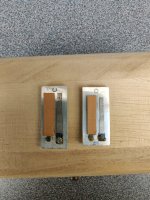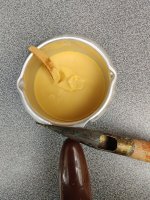Clairejen
Newbie
I've embarked on a repair job with a small Weltmeister accordion I acquired cheaply. The wax is brittle and several reeds have fallen out, on investigation they should all be rewaxed. I've made my wax (20% rosin to 80% beeswax) and started removing the reeds. I've got a couple of questions as this is my first foray into repairs and I'd really appreciate any help I can get!
The reeds are punched with an O (though on some it is a U but I suspect that is poor punching). There seems to be no logic in whether the O is facing outwards or inwards in the block. Does this matter?
There seem to be various methods of applying the wax, going by videos I have watched. I've got it in an old chocolate melting pot which will keep it molten but not overly hot while I'm working. I have a tjanting, which is obviously designed for wax work, would that be a suitable implement to use? I've never seen anyone use a small glue gun but I imagine that could be an option if I formed glue sticks. Other than that I have soldering irons and paint brushes, both of which I've seen used. Whatever I choose, I will practise on some scrap wood and metal before attacking the accordion. Any recommendations or warnings?
The reeds are punched with an O (though on some it is a U but I suspect that is poor punching). There seems to be no logic in whether the O is facing outwards or inwards in the block. Does this matter?
There seem to be various methods of applying the wax, going by videos I have watched. I've got it in an old chocolate melting pot which will keep it molten but not overly hot while I'm working. I have a tjanting, which is obviously designed for wax work, would that be a suitable implement to use? I've never seen anyone use a small glue gun but I imagine that could be an option if I formed glue sticks. Other than that I have soldering irons and paint brushes, both of which I've seen used. Whatever I choose, I will practise on some scrap wood and metal before attacking the accordion. Any recommendations or warnings?


